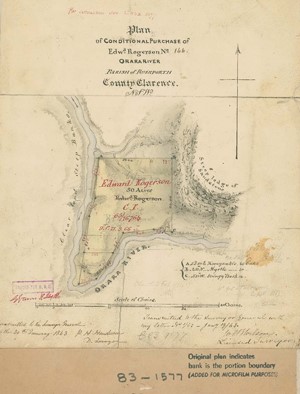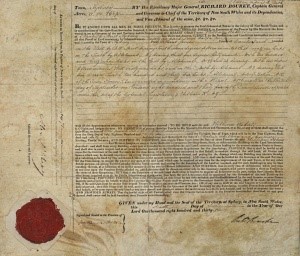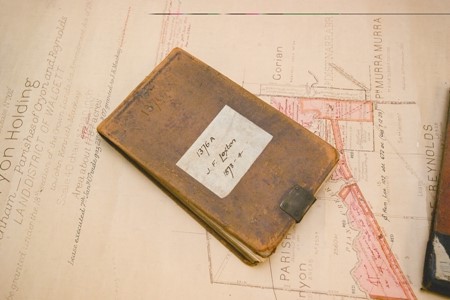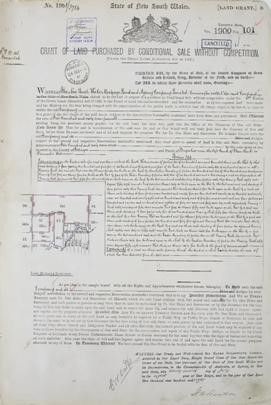Following a major digitisation program by NSW Land Registry Services (NSW LRS) and the NSW Government, you can access over 19 million land records and historical documents online. The program converted NSW titles into an electronically delivered Torrens Title system and digitised one of the largest holdings of archival records in the state.
By imaging records and transferring the originals to NSW State Archives and Records, the program ensures the long-term preservation of these valuable historical documents which are amongst the oldest of the State of NSW.
Where to find digitised NSW LRS historical records
Records that have been imaged or converted to the digitised titling system can be accessed online, over the counter at NSW LRS, via NSW LRS public terminals or NSW State Archives and Records, in-person at the State Library and through approved Information Brokers.
Find out more about NSW LRS self-serve and assisted information services.
Which records are available online?
A range of historical records are available online following their digitisation, listed below. Click on the linked items for access to or tips for searching those digitised records.
* These records are available in the Historical Land Records Viewer (HLRV).
Accessing titling records online
NSW LRS’ network of approved Information Brokers provide access to NSW titling information including plan and dealing images.
You can also conduct free database searches via the NSW LRS Online Portal.
NSW State Archives and Records
Public terminals at NSW State Archives and Records reading rooms (Kingswood) allow access to many scanned images and documents.
NSW State Archives and Records also offers additional features for historical researchers:
Public terminals are also available at the State Library of New South Wales to access NSW LRS digital records.
Tips for searching historical information
Plan lodgment books
The Plan Lodgment books, also known as the Register of Deposited and Strata Plans, were used between 1863 to 1995 to record details of deposited plans, strata plans (only since 1961), and a range of other plans lodged with NSW LRS.
These include miscellaneous plans of subdivision (both Old System and Real Property), Crown Authority plans, Housing Commission plans and Old System Registered plans. All but the strata plans have been re-catalogued as deposited plans.
The books have all been scanned and the physical volumes transferred to NSW State Archives and Records.
How can these records help?
Use the NSW LRS Online portal to check document and plan status - a free online inquiry.You may want to look here for additional details, such as the plan lodgment date, the owner of the property at date of lodgment, or the Vol/Fol of the title being affected by the plan. Other details such as names of surveyors and lodging parties may also be found in the later registers.
Accessing records: Free public access
Scanned images of the Plan Lodgment Books are available free of charge through the Historical Land Records Viewer (HLRV). The scanned images are free to view.
Identifying records
The images of the Plan Lodgment Books are in sequential order. An image equates to one page from the books and multiple plan lodgments are shown on each image. Once the index in the Historical Land Records Viewer is complete users will be able to search for the relevant page by the plan number and an image of the page will be displayed.
Historical Maps (cancelled editions)
‘Cancelled’ editions of historical maps were created when a parish or town 'charting map' maintained by Crown Lands had so many amendments that no more changes could fit on it.
How can these records help?
Parish and Town maps are an important index to land information. By examining previous editions of maps at different points in time, you can see how subdivisions and other actions have altered property boundaries.
The maps:
-
show the boundaries of individual land parcels in relation to physical features such as roads, rivers, railways and seashores
-
provide a reference to the Crown plans, the official survey plans for those parcels
-
may show the name of the first land owner, grantee or lessee and the first title information (Vol-Fol) for each parcel granted after 1863
-
shows administration activities over Crown lands such as reserves, licenses, leases and roads.
Accessing records: Free public access
Scanned images of these historical maps are available free of charge through the Historical Land Records Viewer (HLRV). The scanned images are free to view.
Identifying records
The maps are generally identified by County, Parish and edition. NSW is divided into 141 counties, which are further subdivided into 7,515 parishes. It is important to select the correct County as the same Parish name can exist in multiple counties.
If you don't know the Parish name, use the Geographical Names Register to search by locality or suburb. The result of the search will include the Parish and County name.
In the Western Division, County maps remain the main historical reference map, except for proclaimed towns and villages that have their own maps.
Real Property dealings
In the Torrens Title ‘dealings’ are transactions affecting a property, such as a transfer, mortgage or lease. Dealings on Torrens Title properties dating from 1863 to the 1990s have been converted from 16 mm microfilm to a digital format.
How can these records help?
Some dealings that relate to current titles may need to be examined in connection with a current land transaction.
In historical research there may be details on the dealing not shown on the title folio e.g. the value of a transfer, details of buyers and sellers, terms and conditions of a mortgage or details of easements and other encumbrances.
Accessing records: Available to purchase
Copies of historical dealings are available for purchase over the counter at NSW LRS or through authorised Information Brokers .
Identifying records
The records are identified by a 'dealing number', usually a number prefixed by a letter of the alphabet. Dealing numbers are shown in the Torrens Purchasers Index and are usually on the Torrens Title folio. These can be:
Crown plans
Crown plans are mostly survey drawings illustrating the land boundaries and physical features of specific parcels of land and may include references to early tenures and ownership of the land. The plans date back to 1792 and earlier. Over 40 per cent are still current and provide the survey diagram for a title. The remainder have been replaced by deposited plans and strata plans but are of historical interest and the basis of all later plans.

How can these records help?
The parish map helps you find the Crown plan which has survey details and land dimensions and size. Often the plan will show physical features, neighbouring owners, Government Gazette references and other particulars regarding the land which can help understand the history of a parcel of land.
If the Crown plan is current it provides the current legal boundaries of the land.
Accessing records: Free public access to view, and records for purchase
Crown plans can be viewed free at public terminals at NSW State Archives and Records in Kingswood, NSW. They are not available through the public terminals at the State Library or NSW LRS.
Crown plans can be purchased, over the counter at NSW LRS or through authorised Information Brokers .
Exception
There are 6,508 early Crown plans listed on the NSW State Archives and Records website. These plans are progressively being conserved, scanned and loaded for online delivery.
Identifying records
Crown plans have an identification number which is typically in the format NNNN-nnnn The second number, also known as the small number, represents the plan series and the first, or large number, is allocated sequentially within the series. For example, plans with the small number 1603 are road plans. To find the number, a common starting point is a Parish map, accessible free through the Historical Land Records Viewer (HLRV).
NSW LRS is converting a large percentage of Crown land parcels to Torrens Title, giving the properties a Torrens Title reference and incorporating them in the computerised titling system. Each converted Crown land parcel has a unique lot and plan identity in the format e.g. 701/1654321. This is the title reference.
Crown land not converted to Torrens Title includes:
-
National Parks and State Forests
-
Jetties
-
Crown land parcels in the Western Division
-
Enclosure Permits
-
Crown roads and waterways
Contact your local Crown Lands regional office for further information about properties of interest.
Deposited plans
Deposited Plans (DP) define legal boundaries of land and often record subdivisions, easements, resumptions or are prepared to support Primary Applications. The first 10,000 deposited plans will be re-scanned in colour to make colour markings and other details more legible.

How can these records help?
Current plans are usually in black and white. The new colour images will present an improved view of the original document.
Accessing records: Available for purchase
At present, only previously scanned images in black and white are available for purchase through authorised Information Brokers.
Identifying records
Deposited plans are identified by a 'DP' number, e.g. DP 825310. Use the free Street address inquiry in the NSW LRS Online Portal to identify a lot and deposited plan number.
Deposited plans that are no longer current can be found using charting maps and reference maps in the Historical Land Records Viewer.
Manual Torrens Titles
After NSW LRS’ computerised titling system was established in 1983, Torrens Titles in manual form were progressively brought into the computerised system. In 2004 NSW LRS undertook the conversion of the remaining manual Torrens Titles, in particular those titles that could previously not be accommodated in the system. These titles included titles for single lots held in shares and titles for multiple parcels with shares now known respectively as Sub folios and Auto Consol Sub folios.
How can these records help?
Having records in the computerised system simplifies finding and confirming the current title.
Locating the Vol/Fol reference for a manual folio can take time as the Street address inquiry in the NSW LRS Online portal does not reference manual titles.
Accessing records: Available for purchase
The computerised manual titles searches can be searched over the counter at NSW LRS or through authorised Information Brokers.
The free Street address inquiry in the NSW LRS Online Portal can be used to find the new title reference for the property.
Identifying records
The computerised manual titles have a title reference number, usually in the format 2/43333 or 2/43333A for a Sub folio. The title reference can usually be found by using the free Street address inquiry in the NSW LRS Online Portal.
Old System records
NSW Land Registry Services (NSW LRS) is converting much of the remaining properties held under Old System to Torrens Title and registering them in its computerised system. Initially these titles are qualified (they are not guaranteed by the state of NSW) and may be limited (a new survey is required to determine legal boundaries).
An application can be made to remove the qualification after six years if the property is sold or transferred for value, and 12 years if it is not sold or transferred.
See more information on Torrens title and Old System.

Conserving Old System records
NSW LRS scanned and conserved key Old System record sets as part of a major program to make more records available online – including the earliest land records of New South Wales.
So far the Old System Grant Register and Index, Old System Vendors Index and Old System Purchasers Index have been scanned and are available online. These records are part of the Old System titling system and are four of the top five priorities identified by internal and external stakeholders. The other priority record set is the Old System deeds. This collection is progressively being scanned and loaded online.
Old System record set
|
Description
|
Images (estimate)
|
Old System Grant Register
(1792 to 1862) |
Grants and purchases of land in NSW. |
86,000 |
Old System Grant Index
(1792 to 1862) |
Index to the Old System Grant Register. |
4,500 |
Vendors Index
(1825–1987) |
Index of people/organisations that sold property or goods. This index relates to the Old System General Register of Deeds. |
611,000 |
Purchasers Index
(1896–1987) |
A reverse index to the Vendors Index, but for a smaller time period. This index relates only to land in the Vendors Index. |
149,940 |
| General Register of Deeds |
Land deeds relating to Old System or common law freehold land |
13.6 million
(3,901,000 deeds) |
Books have been progressively removed from NSW LRS, Sydney and sent to Bathurst for scanning, and conservation treatment if required. Once scanned, these records are transferred to State Archives, with NSW LRS continuing to house the remaining Old System records.
Accessing records
Those books which have been removed from the shelves, and are yet to be processed and loaded onto the public terminals, can be requested from the Old System Records counter at NSW LRS. The requested pages will be re-prioritised for prompt delivery.
Once each record set has been completely scanned, metadata captured and images quality assured, they will be made available via the Historical Land Records Viewer (HLRV). Once loaded onto the viewer the books will be searchable, as per the current manual procedure, by the first letter of a surname and date range of the book.
More information
NSW LRS has produced detailed guides which describe Land Title Systems in New South Wales and which assist you in conducting searches of current and historical information. The guides are available to view or download for free.
Information sheets on how to access the Old System records through HLRV are also available.
Miscellaneous historical plans
A large variety of historical plans, currently available on 35mm microfilm, are being digitised to enable online access. The plans include City of Sydney Alignment plans and Water Board Detail Sheets.
How can these records help?
These are specialised plans and may not interest a wide audience. Surveyors and others will benefit from online access of these plans instead of requesting copies of aperture cards held in Level 30, 175 Liverpool Street.
Examples of plan use
City of Sydney Alignment plans show Sydney’s early street alignments and property boundaries and indicate building locations as well.
Accessing records: Available for purchase
Images are available for purchase over the counter at NSW LRS. When scanning is complete plan images will be available through authorised Information Brokers.
Identifying records
The numbering scheme for the miscellaneous plans is currently being developed.
Surveyors' Field Book Index
Surveyors in the field used small books to record both survey data and notes as surveys were carried out. They often contain notes about buildings and topography, astronomical observations for charting coordinates, boundary marks and other details that go beyond what is shown in the Crown plans and other registered plans that resulted from the surveys.
The indexes of the Surveyors’ Field Books are now being transcribed and work on creating a free online database of the captured field book indexes has commenced. This will assist in the search and retrieval of the books as they are progressively transferred to NSW State Archives and Records.

How can these records help?
If you are interested in a particular parcel or locality the surveyor’s notes may provide further information to what is shown on the Crown plan or deposited plan. They may also provide information regarding buildings, terrain and even flora and fauna. The notes are also useful in resolving uncertainties about boundaries as they contain information about boundary marks and how the survey was conducted.
Four series of books
The Surveyors’ Field Books consist of four key series:
- Ordinary (O) - These books were forwarded to the Surveyor General from licenced surveyors covering the years 1798 to 1947.
- X and Y series - 1600 books issued to NSW Land Registry Services staff surveyors between 1925 and 1933.
- Lands Department (LD) - 8,700 books issued to staff surveyors between 1933 and 1974.
- New Series - These books were used from 1974 and are numbered by year and region, each office using the same numbers.
Accessing records: Available for purchase
Transferred field books can be requested for viewing at NSW State Archives and Records in Kingswood, NSW, or books can be retrieved by NSW LRS for a retrieval fee.
To access field books undergoing data entry, or to find out if a book has been transferred to NSW State Archives and Records, contact NSW LRS.
You can arrange for pages to be copied at a fee from books still at NSW LRS. For a fee, you can also arrange for books at NSW State Archives and Records to be retrieved for viewing and copying.
Identifying records
The field books are identified by a field book number and by the name of the surveyor. In most instances these can be found on the Crown plan. It is useful to know an approximate date of the field book or survey and location details of the land, e.g. Parish and County.
Torrens Purchasers Index
Established in 1863 when the Torrens Title system began, the Torrens Purchasers Index is a key means for finding when a person or corporation:
- became the owner of Torrens title land or
- became the holder of a registered lease over Torrens Title land or
- received a grant of Crown land, from 1863 onwards, grants were recorded in this index rather than in the Grant Index.
The index also lists land resumptions and documents that record a name change to the registered owner on a land title.
The Torrens Purchasers Index was in book form from 1 January 1863 to 31 May 1971. These books are now being scanned to provide online access.
Each index entry provides:
- the full name of the person or corporation being registered as the owner or leaseholder of the land
- the Volume and Folio of the manual title folio
- a dealing number, with a prefix like T, L, or G that shows that this is a transfer, lease, grant, etc.
- the location of the land in terms of parish, county and locality.

How can these records help?
This index enables you to locate manual Torrens Title folios, which can then be purchased through authorised Information Brokers.
Earlier Old Form Torrens folios are available for free viewing on the Historical Land Records Viewer (HLRV) or on public terminals at NSW LRS, NSW State Archives and Records and the State Library.
Accessing records: Some free to view, and some records for purchase
For the Torrens Purchasers Index up to 1971, records are available free online in the Historical Land Records Viewer (HLRV).
For records from the Torrens Purchasers Index after June 1971, inquiries can be made over the counter at NSW LRS or through authorised Information Brokers.
You are required to verify your identity and provide a reason for seeking the information before the search will be conducted. Identity documents must include a current photo identification and one other form of identification. For more information see NSW LRS Circular 2004/12 (PDF 260 KB).
Identifying records
The Torrens Purchasers Index is organised alphabetically, within chronological periods.
- The first books in the index cover transactions occurring between 1863-1867, with each book covering a portion of the alphabet.
- The next set of books covers the period 1868-1872, again with books going from A to Z.
As an example of how individual books are labelled, the book '1891-1895 E-F' covers the E and F names during the period 1891-1895 and you would examine this book if you were looking for a purchase by John Ford around 1892.
Until all the index books are available online, you need to come to Level 30, 175 Liverpool Street, Sydney to view the index.
The Old Form Torrens title folios can be viewed free at home through the Historical Land Records Viewer, the NSW LRS office, NSW State Archives and Records or the State Library.
Both Old Form and New Form Torrens title folios can be purchased through authorised Information Brokers.
Old Form Torrens Register
Before computerisation, titles created using the Torrens system existed as paper documents, called manual folios.
From 1863 to 1961 the folios were stored in bound volumes, numbered 1 to 8497. This became known as the Old Form Torrens Register when, in 1961, a new system of loose-leaf folders, called the New Form Torrens Register, was introduced.
Folios in the Old Form register show:
- owner (or lessee)
- origin of title (grant, purchase details, primary application)
- previous title reference and successive title reference numbers
- land descriptions and diagram sketches of land (in all but the most modern entries)
- memorials that record brief details of mortgages, transfers to owners and other dealings.
Except for the Sydney Harbour Foreshore and Holt Sutherland Estate folios, the Old Form Register, consisting of over two million titles, has now been imaged in colour and the original documents have been transferred to NSW State Archives and Records. This preserves these important records and provides greater public access to them.
The majority of folios in the bound register have been cancelled and replaced by computerised titles.

How can these records help?
By examining the manual folios for a property over time, you can see the sequence of owners. This could help you find the date a property was purchased or sold.
The manual folios are also a key way to find the 'dealing number' for a transfer, mortgage or other transactions. Using this number, you can order an image of the dealing, which may contain monetary figures, occupations of the parties and other information.
Accessing records: Free to view and available for purchase
Old Form Torrens title folios can be viewed free of charge through:
Old Form and New Form Torrens folios can be purchased through authorised Information Brokers.
Identifying records
The Torrens title folios are identified by a title reference consisting of a Volume and a Folio, e.g. Vol 2333 Folio 23.
Volume and Folio number known
If the Volume is 8497 or lower, the folio is an Old Form folio and you can view it on the Historical Land Records Viewer or on a public terminal at NSW State Archives and Records or the State Library. If the Volume is higher than 8497, the folio is a New Form folio and you have to purchase a copy from an approved information broker or over-the-counter at NSW LRS.
Volume and Folio number NOT known
Three common ways to find the Vol/Fol you need is by:
- searching back from the current title for a property
- searching forward from the grant or first title reference, which are often found on parish and town maps. These can be examined free through the Historical Land Records Viewer.
- looking for the purchaser's name in the Torrens Title Purchasers Index. You need to come to Level 30, 175 Liverpool Street, Sydney to see this index until its available online.